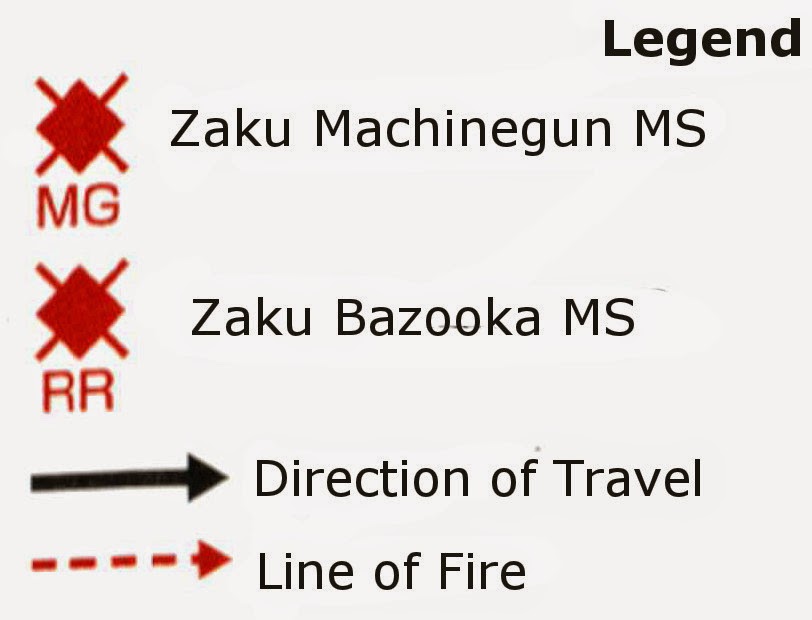One of the most fundamental reasons for Zeon’s huge successes at the outbreak of the war are the effective Mobile Suit tactics employed by the Zeon MS corps.
Using a squad of three Mobile Suits, this article will demonstrate how to successfully execute an Anti-Ship assault with detailed formation explanations.
Though in most cases Zeon warships carried a complement of six Mobile Suits, in practice one of these was typically a reserve suit, and so regardless of space or ground operations, the standard MS squad consisted of three Mobile Suits. Until the Earth Federation Forces were able to mass produce their own Mobile Suits, the primary targets for Zeon MS forces were Battleships, Cruisers, Transport ships, and their defending fighter escorts. Prior to the outbreak of the war, the Zeon forces had done considerable research in Mobile Suit employment, though the tactics were finally validated at the Battle of Loum, and afterwards supplmented by combat experience.
The superiority of the Mobile Suit for Anti-Ship operations, compared to other spacecraft, came largely from the small size and high mobility and maneuverability of the Mobile Suit, and in a battlefield affected by Minovsky particle scattering, the engagement distances were often limited to visual range, which would naturally lead to close range combat.
Therefore, the small and rapidly moving MS are often able to move faster than the ponderous Federation Battleships are able to accurately fire on them. Moreover, one challenge that the Zeon military consistently faced was the challenge of “maintaining tactical advantage with minimal losses”, and the standard Anti-Ship formation discussed here is an evolution of the strategy with this challenge in mind.
Single Squad Anti-ship Assault Mission Basic Tactics
- Closing formation
First, the MS squad forms a triangle formation with the commander’s unit in the front, oriented towards the attack objective when approaching the target. This formation is typically adopted by the wingmen after the commander identifies the target.
- Attack formation
. After closing with the target, the wingmen on both wings who will be using bazookas to attack the target change formation into a reverse triangle, with the Commander’s unit trailing and providing support, as well as battle damage assessment. After the battle damage assessment, the three units will disperse to avoid anti-aircraft fire and withdraw.
- Approach, Attack, and Withdrawal
Point of Attack
When this formation is executed against an enemy ship, the two wingmen attacking from either above or below the enemy ship form the main body of the attack. The commander then closes with the enemy ship even closer than then wingmen, and provides suppression fire with the machine gun to support the withdrawal of the wingmen. This allows the two attacking wingmen to limit their necessary evasive maneuvers in order to increase their accuracy and concentrate their firepower. Though the result is that the commander unit is exposed to a greater level of danger than the wingmen, it may be surprising that some pilots who are able to avoid the rain of enemy fire and attack the ships weak points or bridge with the machine gun are known to exist.
In the Battle of Loum, the Black Tri-Stars, known as the famous team of pilots who captured the Federation’s top commander Lt. General Revil, were known to use a different formation than the standard formation discussed previously.
This so-called ‘Jet Stream Attack’ is a simple attack formation in which the two wingmen are concealed behind the commander’s unit during the approach to the enemy ship, providing a smaller target and reducing the effectiveness of the barrage of enemy fire.
However, as the wingmen must maintain this formation even through evasive maneuvers and perform all movements in parallel, a very high degree of pilot skill is required for this attack formation.
Source: Another Century's Episode Vol 1.: One Year War Complete History Part 1. Gakken Mook, 2007.
Source: Another Century's Episode Vol 1.: One Year War Complete History Part 1. Gakken Mook, 2007.





No comments:
Post a Comment